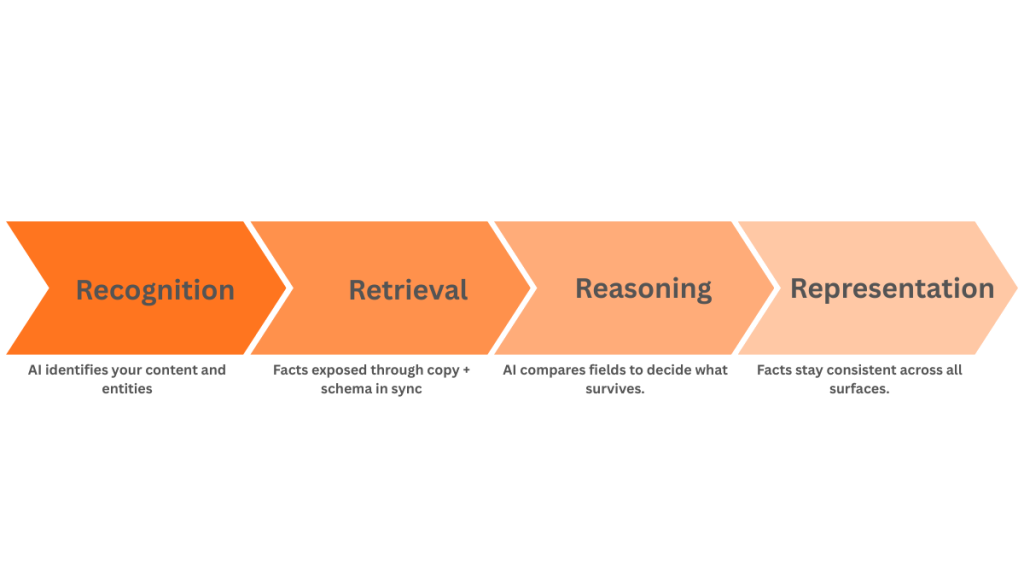Foundational Mechanics
The steps that separate the sites that appear from the ones that don’t.
AI answers are already shaping search results, but most brands never make it into them. Google itself has said that AI in Search is “driving the most significant upgrade of the Search experience ever” and that people are clicking more — not less — as AI Overviews expand the kinds of questions they ask. Not because AI ignored them, but because they aren’t yet optimizing for AI. Your content has to survive a series of checkpoints before it earns a spot. This post introduces the Four R’s. which are the survival gates that decide whether your brand disappears or shows up in AI answers.
Why Most Brands Don’t Appear in AI Answers
Search engines once focused on visibility: could your page be crawled, indexed, and ranked? Today, that’s only the starting point. Generative AI applies more layers before it decides whether to trust your facts.
Each R represents one of those layers. First, AI must recognize what your content is. Then it must retrieve it in a form it can classify. From there, it reasons with the attributes, comparing one fact against another. Finally, it represents that fact consistently in answers, which depends on checks for accuracy and stability.
The key is that these stages are sequential. If your RV model isn’t recognized as an entity, it won’t be retrieved. If it can’t be retrieved in structured form, reasoning has nothing to work with. If your schema drifts out of sync with the copy on the page, representation collapses and your fact drops out.
Most SEO today stops at retrieval. Markup may get a page indexed, but without consistency and governance, the facts don’t survive the later gates. Optimizing for AI is about preparing your content to make it through the entire sequence.
This sequence also determines your answer share, meaning how often your facts appear in AI-generated responses. That’s the real measure of AI answer optimization.
The Four R’s of Optimizing for AI Answers
Recognition: Making AI See Your Entity
AI must first recognize your content as an entity with attributes, not just a block of text.
If you describe an RV, the system needs to understand it as a distinct product with measurable details like seating capacity, price, and fuel type. Without this step, your RV description is just words in a sea of words.
For example, “this RV sleeps four” is clear to a human but vague to AI. Stored instead as seatingCapacity = 4, it becomes a fact the system can recognize and query. Recognition starts with entity-first writing and schema that make the subject unambiguous.
Retrieval: Exposing Facts with Schema Markup
Once recognized, facts must be exposed in a structured, machine-readable way. This is where schema markup (structured data in formats like JSON-LD) comes in. Retrieval is what puts your attributes onto the AI’s internal map.
If your RV’s capacity is only in a paragraph, it may be overlooked. If it is also in schema, the AI can reliably retrieve it. Retrieval only works when attributes are consistently surfaced in structured data for AI.
Reasoning: How AI Chooses Between Competing Facts
Reasoning is the point where the system decides which fact to use. Unlike SEO rankings, which weigh signals like links, reasoning compares structured fields directly.
Take the query: “best small RV for a family of four under €150 per night.” To answer, AI must combine seating capacity, price, and category fields across multiple sources. If your RV has those values stored in fields, you are in the race. If they are buried in prose, you are invisible.
As Google has described in its AI updates, this process often involves breaking a query into subtopics, running multiple searches, and reassembling an answer from structured facts. In other words, AI answer optimization is not about one page “ranking.” It is about your attributes surviving the comparison stage.
Representation: Keeping Your Facts Consistent Over Time
Finally, facts that survive reasoning must be represented consistently. Representation depends on your structured data staying in sync with visible content. This is known as schema parity.
If your schema says “sleeps four” but your page copy says “family of five,” the fact collapses. If schema disappears during a client-side transition, your RV will not show up in future answers.
Representation relies on stability: consistency checks, clear templates, and ongoing monitoring. The good news is that these are testable. With the right QA, you can ensure your facts remain trustworthy and safe for reuse.
How the Four R’s Drive Answer Engine Optimization

The Four R’s form a dependency chain. Recognition feeds Retrieval. Retrieval makes Reasoning possible. Reasoning relies on Representation to hold together over time.
This sequence is not optional. If Recognition fails, Retrieval has nothing to work with. If Retrieval fails, Reasoning has no attributes to compare. If Representation fails, even facts that once appeared can vanish later.
Take our RV example. Recognition ensures AI knows it is a product. Retrieval exposes its attributes through structured data for AI. Reasoning lets AI compare its seating and price against competitors. Representation ensures those details stay consistent. Break any link, and your RV falls out of AI responses.
Unlike SEO, where you can get partial wins, optimizing for AI is unforgiving. One weak link can mean total exclusion.
Common Mistakes in AI Answer Optimization
Most AEO attempts stumble because they stop too soon. Retrieval gets attention, while the other gates are left unguarded.
- Schema spam: Adding every possible property without clean data. Looks good at retrieval but fails when AI tries to reason with it.
- Vague marketing copy: Phrases like “perfect for family adventures” persuade humans but do not resolve into facts. Without clear attributes, recognition breaks.
- Schema drift: Updating visible copy (like price) but forgetting to update the structured data. This mismatch makes AI lose trust in your facts.
- Breaking the link: When descriptive copy drifts too far from structured attributes, the connection, known as the interpretive bridge, breaks.
The Four R’s are strict, but not mysterious. Each has clear checks you can run to keep your facts intact.
Closing
The Four R’s are survival gates that every fact must pass through before it can appear in an AI-generated answer. Recognition makes your content identifiable. Retrieval makes it findable. Reasoning makes it usable. Representation makes it reliable.
In AEO vs SEO: Surviving the New Era of AI, we argued that the shift from page-first to field-first thinking is what separates SEO from AEO. The Four R’s show how that shift works in practice.
Visibility alone is no longer enough. If your site cannot provide structured data for AI that is consistent and reliable, you will not just lose rankings, you will lose presence in AI answers altogether.
And remember: the Four R’s only come into play if your site is indexable in the first place. Crawlability and indexation are the ground floor. Without them, there is nothing for AI to recognize, retrieve, reason with, or represent.
The race is already underway. That’s why our next post in the series digs into the foundation itself — Indexability and Retrieval — the two checkpoints every site has to clear before the Four R’s can even begin.
The brands that are already optimizing for AI will set tomorrow’s benchmarks. AEO attempts stumble because they stop too soon. Retrieval gets attention, while the other gates are left unguarded.
